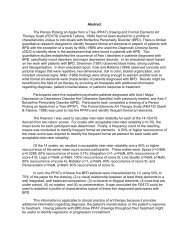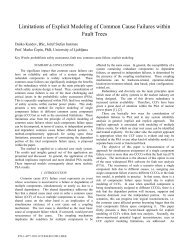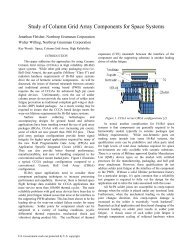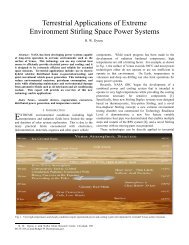Tutorial
Tutorial
Tutorial
Create successful ePaper yourself
Turn your PDF publications into a flip-book with our unique Google optimized e-Paper software.
selection of the approach is imperative. To validate the<br />
decision, implement a prototype FRACAS based on the<br />
selected approach.<br />
5.6 Step 6: Accept feedback and modify FRACAS<br />
At this stage, reconvene the stakeholders and start testing<br />
the prototype system. Does the previously defined workflow<br />
process work in this environment? Can the data be efficiently<br />
entered into the system? Can the expected outputs be<br />
generated? Is the system easy to use and understand?<br />
Most importantly, revisit the goals and success factors.<br />
Does the system meet these goals? Will the success factors be<br />
met? Particular areas will likely need additional tweaking or<br />
reworking. This is the time to accept constructive feedback<br />
and make the necessary modifications.<br />
Before proceeding, gain signoff and approval from all<br />
stakeholders. With their continued involvement, the chances<br />
of gaining their support is high, and they can be the best<br />
advocates for the project when proceeding to the next step —<br />
general rollout.<br />
5.7 Step 7: Rollout and train<br />
Companies can take several different approaches for<br />
general rollout, and each method has its own set of advantages<br />
and disadvantages.<br />
The “Big Bang” approach allows all users on the system<br />
at once. This approach is typically used where time is short.<br />
When all the users begin to use the system at the same time,<br />
many problems are likely. With so many users involved,<br />
seemingly minor issues can become major obstacles.<br />
Although this approach can work, it requires significant<br />
planning and coordination. It should only be considered when<br />
absolutely necessary.<br />
Alternatively, most companies prefer a phased approach<br />
in which several groups at a time are trained and brought<br />
online. In this case, unforeseen issues can be addressed<br />
without involving the entire user base. Additionally, the<br />
implementation and training teams can adapt to provide better<br />
support for later groups. Typically, the more individualized<br />
attention ultimately gains more support and acceptance from<br />
the general user base.<br />
Training is extremely important, especially when typical<br />
FRACAS processes involve users of many different areas of<br />
interest and levels of expertise. When users understand what is<br />
expected of them and are empowered by training to use the<br />
tools given to them, the system has a much greater chance for<br />
acceptance and success.<br />
5.8 Step 8: Continue to change<br />
Continual change should be expected for the FRACAS<br />
system based on user feedback regarding what works and<br />
what needs improvement. As business objectives and<br />
processes evolve, the FRACAS needs to adapt and support<br />
these developments. As a result, active management needs to<br />
accept and validate changes to the FRACAS in relation to the<br />
original high-level goals. Through this oversight, a highperformance,<br />
functional system will remain viable for many<br />
years.<br />
6. PRACTICAL APPLICATION<br />
This section presents several case studies to address the<br />
practical application of FRACAS. In some instances the<br />
FRACAS was implemented as a result of a customer<br />
requirement and in others as an internal decision by the<br />
organization. They represent a range of successful FRACAS<br />
implementations based on systematic steps and the FRACAS<br />
best practices described above.<br />
6.1 Case Study #1: Traditional FRACAS<br />
A manufacturer in the aerospace industry instituted and<br />
continues to use a traditional FRACAS. A desire for reliable<br />
products as well as a customer requirement drove the<br />
implementation. Management established various goals,<br />
especially:<br />
• Capture of incident or failure information in a closed loop<br />
system.<br />
• Provide periodic reports to the customer with the closedloop<br />
resolution for each incident.<br />
The required outputs include metrics like MTBF. Reports<br />
are generated as well including Failure Summary, Failure<br />
Analysis, and Reliability reports.<br />
For workflow, the process follows a series of defined<br />
steps: Incident Entry, Quality Review, Failure Investigation,<br />
Root Cause Analysis, Corrective Action, Failure Review<br />
Board, and Closeout.<br />
Data inputs to the FRACAS include data from the<br />
previously implemented database system as a starting point.<br />
Subsequent data is entered manually using customized tables<br />
and forms for each workflow step.<br />
Two programs initially deployed the prototype FRACAS.<br />
During prototype review, necessary additional reports,<br />
calculations and alerts were identified and the FRACAS was<br />
updated to support the added requirements.<br />
The solution provider supplied training to key users for<br />
the FRACAS on both programs.<br />
Since the initial implementation, the FRACAS has<br />
changed slightly to better suit the organization’s needs.<br />
Modifications are ongoing as new needs arise.<br />
This FRACAS has proven to be a success thanks to the<br />
systematic planning approach used during deployment.<br />
6.2 Case Study #2: RMA System<br />
A supplier to the aerospace and defense industry<br />
implemented and continues to use a FRACAS to manage and<br />
track their return material authorization (RMA) process.<br />
The goals and success factors for the FRACAS are as<br />
follows:<br />
• Efficiently track and manage the RMA process.<br />
• Provide procedures and tools to gather reliability data<br />
from various groups, including customer service, repair<br />
and overhaul, original equipment, and other service<br />
centers.<br />
• Attain reliability data to help with quoting expected<br />
maintenance costs.<br />
6 – Cline & Stillwell 2012 AR&MS <strong>Tutorial</strong> Notes












